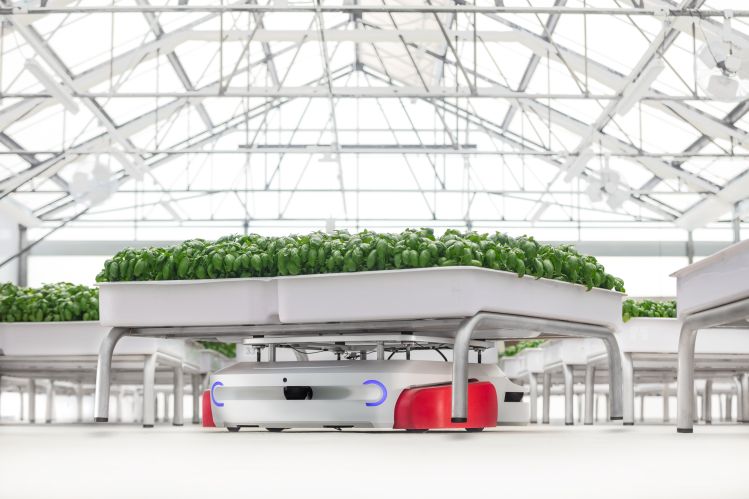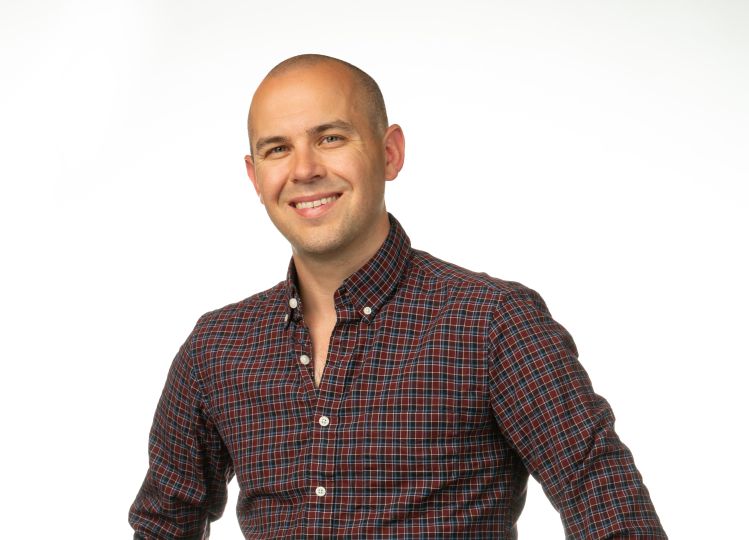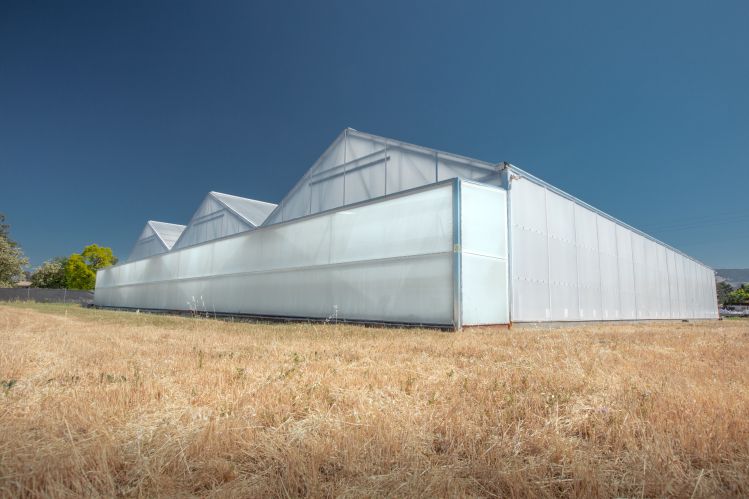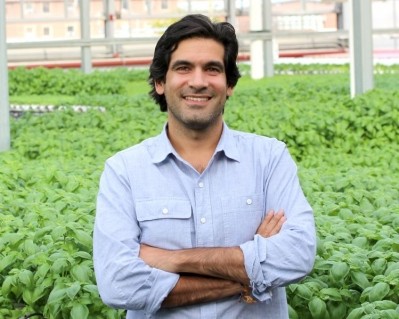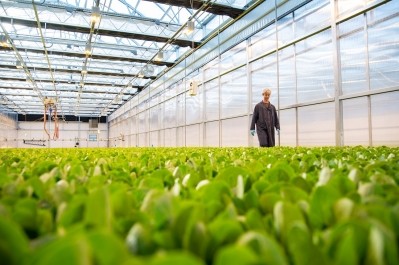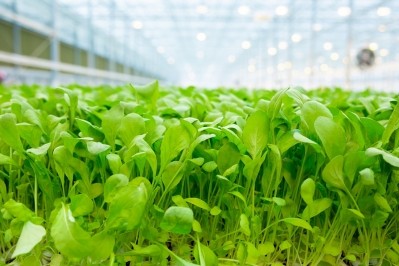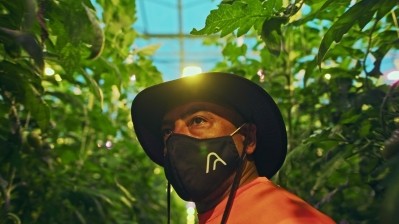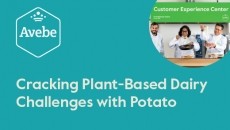Robot-powered indoor farming startup Iron Ox raises $53m, gears up to open 535,000sq ft facility in Texas later this year
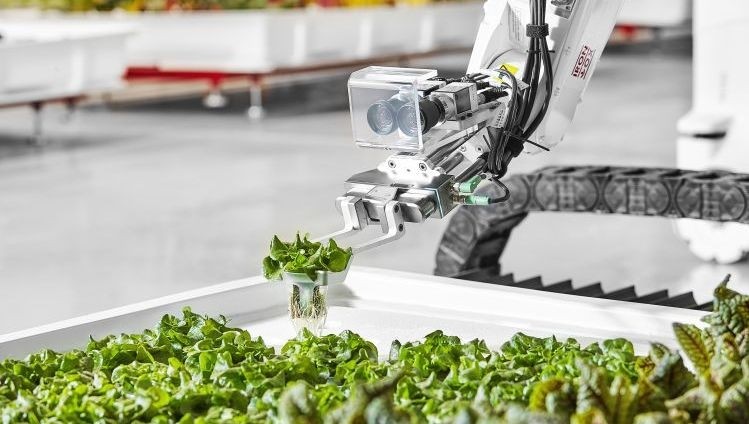
The San Francisco-based firm – co-founded in 2015 by computer scientist Brandon Alexander, who worked on drone delivery at Google before exploring robot-powered greenhouses – initially deployed its technology in a small, LED-powered greenhouse in San Carlos, CA.
This served as a great testing ground for its AI-powered, robotic-enabled growing system, but also proved that utilizing natural light is a cheaper and less energy-intensive approach, Alexander told FoodNavigator-USA.
“It helped us prove that we cannot go on a purely LED-based future. The sun is free.”
Iron Ox’s second facility, in Gilroy, California, which relies on sunlight for its plants to grow, is now operational and supplying a variety of retailers including Whole Foods with leafy greens, strawberries and herbs; while its third, largest, facility, in Lockhart, Texas, will start supplying customers later this year, he said. “A third of our energy production there will be from renewables.”
'We’re not trying to get the plants to fit our system, we’re trying to get our system to adapt to the plants'
But what will distinguish the winners from the losers in the burgeoning indoor farming space, and given that no AgTech pitch deck now seems complete without some reference to machine learning and automation, how does Iron Ox’s approach stand out from the crowd?
It’s not about ‘robots’ per se, said Alexander, noting that most players in this segment deploy a certain amount of automation, but about building highly flexible and adaptable systems that can move with the times rather than building a facility that is totally optimized for producing large quantities, of say, butterhead lettuce, but nothing else.
“One of the unique things about our facilities is that we truly designed them from the ground up with robotics. A decent amount of [firms in] the [indoor farming] space use a lot of off the shelf stuff [industrial automation equipment] from the Netherlands, and there's nothing wrong with that, but we designed our system to be inherently flexible, as we don’t know what the market will want in 10 or 20 years’ time.
“Each one of the 6ft by 6ft hydroponic pallets we use in our system can be quickly changed over to a different crop, so from strawberries to tomatoes, soft berries to lettuce. Our robotic arm scans that palette in 3D and through what's called dynamic motion planning, it knows how to navigate that particular plant.
“So where I say we differ significantly is that we’re not trying to get the plants to fit our system, we’re trying to get our system to adapt to the plants.”
He added: “We have these big scanning booths that take these deep 3D scans of everything that goes through our system [picking up things you can’t see with the naked eye] and then our plant science team works with our engineering team to figure out how can we train our AI algorithm better to start recognizing warning signs such as aphids that show up as little heat zones, for example.”
By making the farm itself modular, with thousands of six by six foot pallets, Iron Ox also has the flexibility to do small test runs with new plants for retail partners, he said. “We can do something on the scale of three pallets or 300 pallets, and customers are liking this a lot.”
Indoor farming, per se, not automatically better
He added: “I don't think we should just pat ourselves on the back because indoor farming is pretty cool. We’ve spent a lot of time perfecting the technology and the robotics, but equally we’ve spent a lot of time developing our own hydroponic system and understanding exactly what every plant needs at every stage, from nutrients to temperature.”
Why is growing some plants in water a better option that growing them in soil?
But what makes growing plants ‘hydroponically’ in water, rather than soil, indoors, more attractive than the age-old practice of growing produce in soil, outside, in the first place?
Significantly-reduced water use is a key factor, along with reduced food miles (growing produce closer to its end market), coupled with pesticide-free claims, greater consistency and reliability (no weather related disruptions), greater yields, and in some cases more flavorful or nutritious varieties with greater consumer appeal, said Alexander.
“A lot of produce today has been down-selected over the past few decades because of robustness and transportation life. I don't think anyone has ever said, ‘I love Iceberg lettuce.’ But it's so dominant because it lasts long, and it's easy to transport, although it has the nutritional value of crunchy water.”
If you’re producing more locally, he said, “We can actually optimize for things like taste and nutritional value.”
Giving plants exactly what they need
In general, he said, while there are some clear advantages to hydroponics, the approach can still become a lot more efficient and sustainable.
“Our goal is zero waste, every joule of energy, every liter of water, every gram of nitrogen or phosphorus, we’re looking at exactly what the plant needs, no more, no less.
“So a baby plant doesn't absorb as much magnesium and calcium as an adult plant, for example, but as an industry we have basically given the same fertilizer, the same nutrients throughout the entire lifecycle. Do we need to change the acidity of the water, change the nitrogen levels? Exactly when is a plant ready for harvesting?”
Investors: We’ve seen a huge shift just in the last 12 months to a focus on sustainability
Asked how investors are viewing the space, he said, “We've seen a huge shift just in the past 12 months. There's a lot more emphasis now on sustainability [in addition to pure economics]. We noticed a massive shift even between our B and C rounds. Breakthrough [Energy Ventures] has been pitched by every indoor farm out there, and they did not invest in them and they almost left us in the same category.
“The reason they ended up investing is because we're the only farm they’ve seen that is taking that truly ground up approach, the hydroponics, the robotics, the feedback loop, the AI, the plant science. To get to carbon neutral and eventually to carbon negative, we have to push the boundaries of our understanding of plants.”
